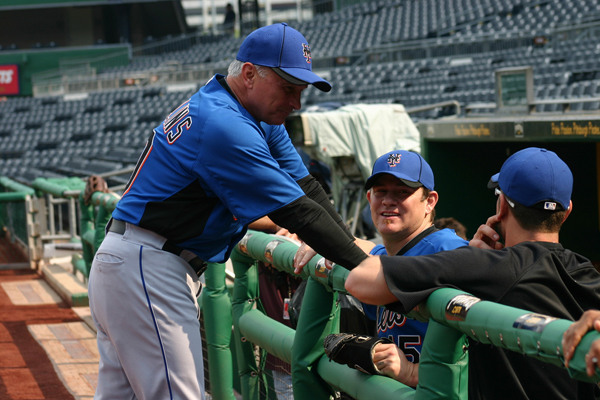

 So here we sit, three-quarters of the way through the 2011 season and the Mets are limping their way into the final stretch of the season.
So here we sit, three-quarters of the way through the 2011 season and the Mets are limping their way into the final stretch of the season.
The 2011 season for the Mets will be remembered fondly, even if the team’s record at the end of the season will potentially indicate they were worse than the 2010 version – which is certainly not true.
Last season, the Mets finished 79-83 and the season was deemed a total disaster. Jerry Manuel was a lame-duck manager, Omar Minaya was a dead man walking and the future of the Mets seemed cloudy and full of despair.
Every game felt like a death sentence and each loss seemed like the next step towards an inevitable downfall of the current regime.
But things have changed.
Now, the Mets are 69-71 which is actually one game better than last year at this time. Even if the Mets were to tailspin and finish below last year’s mark, the perception of this club and its direction has changed drastically in only one years’ time.
Highlighting this fact was a “long time National League East rival” saying “This year, when you look at the Mets, it’s not like, ‘Oh my God, what the [expletive] is this?’”
So what is so different about this year’s Mets?
The Mets plans are now strictly run on calculation and skill – not misplaced loyalty or personal favors like our former front office. Sandy Alderson, who replaced Minaya at the helm before the beginning of this season, has changed the culture and perception of the Mets.
Instead of old veterans throwing punches at family members or front office personnel challenging minor leaguers to fight, the Mets now boast a roster of young talented players constantly competing and attempting to prove their worth to the Mets future plans.
Players like Lucas Duda, Nick Evans, Dillon Gee, Pedro Beato and others have been impressing as they audition for a role in next year’s plans and beyond.
What this drastic shift has done has changed the Mets from an aging franchise heading towards a dark age to a team in transition, with a fire and passion that has not been seen in a roster since 2006.
This is where Terry Collins’ credit is deserved.
The energy and determination Collins has instilled into the team’s mindset is clearly evident. Instead of giving up in the sixth inning like in years past, this year’s squad has a “never-say-die” mentality that has made the team exciting, fundamentally sound and actually makes the Mets seem like an actual team – not the league’s laughing stock.
I’ll admit I was skeptical at Alderson’s hiring of Collins last winter. His track record was not overly inspiring, he was supposed to have a short temper and his players had turned their back on him during his former stints as manager. I was convinced Collins and his short fuse would burst under the intense microscope of the New York media. But none of those problems have even come close reappearing and in fact, the team has been praising him for all of the exact opposite reasons.
The manager’s intensity and winning attitude seems to resonate with the roster and has been infectious as the team overachieved for much of the earlier portion of the season.
In fact, a playoff run was not out of the question in May when things seemed to be breaking in the Mets direction for the first time in years. Jose Reyes was having an MVP-type season, the starting rotation was clicking, the bullpen recovered from their early season implosion and the team looked poised to be the Cinderella of the league.
While the fairy tale did not end the way some might have imagined, the very fact this team overachieved as much as it did is a clear example of how the new regime has changed this team.
So what does this mean? Where will the Mets land come the start of next season? If I had to guess, I would expect these next few months to be quiet as the Mets and Alderson make calculated moves towards a future that includes some of the more promising youngsters in our farm system.
